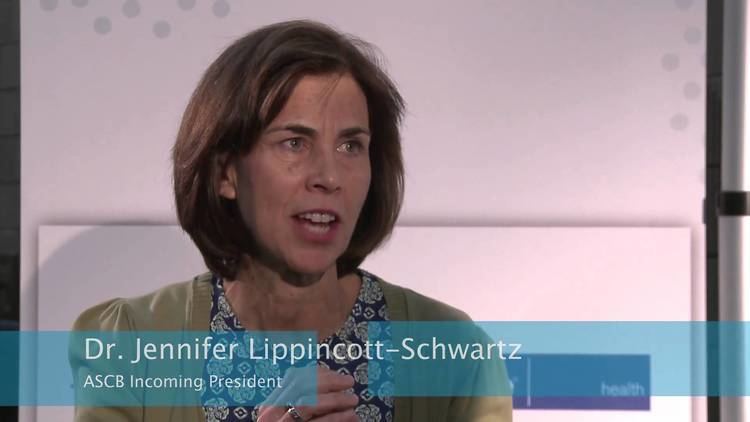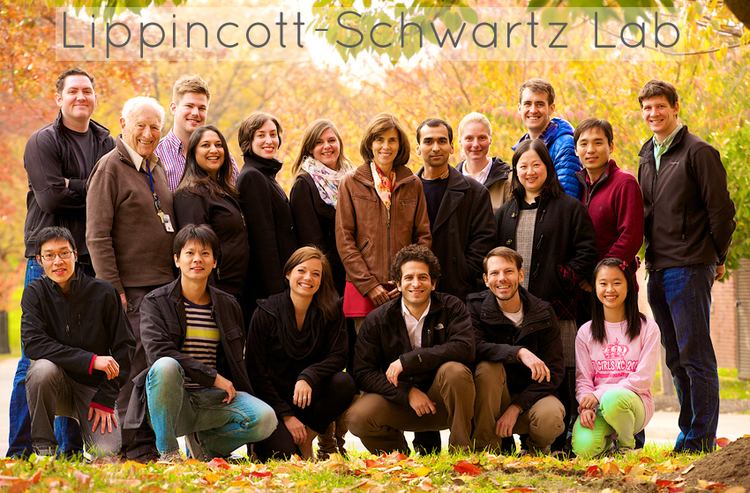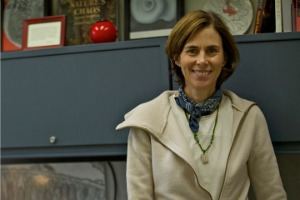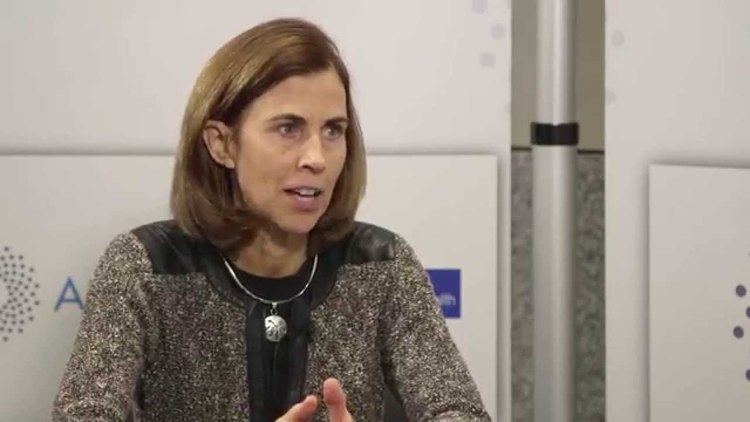Fields Organelle Biology Known for | Spouse Jonathan Schwartz | |
 | ||
Born Jennifer Lippincott 19 October 1952 (age 72) Manhattan, Kansas ( 1952-10-19 ) Alma mater Swarthmore CollegeJohns Hopkins University Name Jennifer Lippincott-Schwartz Education Johns Hopkins University, Stanford University, Swarth College | ||
Jennifer lippincott schwartz nih how do lipids and cholesterol regulate the secretory pathway
Jennifer Lippincott-Schwartz is the Chief of the Section on Organelle Biology in the Cell Biology and Metabolism Program, in the Division of Intramural Research in the Eunice Kennedy Shriver National Institute of Child Health and Human Development at the National Institutes of Health. Lippincott-Schwartz received her Ph.D. from Johns Hopkins University. Following Johns Hopkins, Lippincott-Schwartz completed her post-doctoral training with Dr. Richard Klausner at the NICHD, NIH in Bethesda, Maryland.
Contents
- Jennifer lippincott schwartz nih how do lipids and cholesterol regulate the secretory pathway
- Jennifer lippincott schwartz nih part 1 intracellular fluorescent imaging an introduction
- Early life
- Later life
- Green fluorescent protein
- Cellular trafficking and patterns
- Photoactivatable GFP
- Photoactivation localization microscopy
- Lippincott Schwartz Lab current projects
- Professional awards
- References

The current research of Lippincott-Schwartz has helped to debunk the traditional ‘static’ view of molecules in cells including the methods of secretory membrane trafficking, compartmentalization, and trafficking of eukaryotic cells. Her research involves multiple live cell imaging techniques in order to study the dynamic interactions of molecules in cells and has led to a more lively view on the inner-workings of the cells. Such live cell imaging techniques include green fluorescent protein fusion alongside photobleaching and photoactivation techniques which allow investigation of subcellular localization, mobility, transport routes, and turnover of important cellular proteins related to membrane trafficking and compartmentalization. Lippincott-Schwartz's lab also tests mechanistic hypotheses related to protein and organelle functions and dynamics by utilizing quantitative measurements through kinetic modeling and simulation experiments.

Within Lippincott-Schwartz lab, current projects include several cell biological areas. For example, protein transport and cytoskeleton interaction, organelle assembly and disassembly, and cell polarity generation. There are also projects analyzing the dynamics of proteins that have been fluorescently labeled. These proteins are labeled using several live cell imaging techniques such as FRAP, FCS, and photoactivation.

Lippincott-Schwartz has dedicated her most recent lab research to photoactivation localization microscopy (PALM), which allows the viewing of molecular distributions of high densities at the nano-scale.

Jennifer lippincott schwartz nih part 1 intracellular fluorescent imaging an introduction
Early life

Jennifer Lippincott-Schwartz was born on October 19, 1952 in Manhattan, Kansas. Her father was a professor of physical chemistry at the University of Maryland and a periodic table could be found hanging in her family’s household kitchen. Lippincott-Schwartz’s exposure to her father’s work is what sparked her love of science. Early in Lippincott-Schwartz’s life her family moved to College Park, Maryland. However, it was not long into her teenage years that the family moved once again to a farm in Northern Virginia. The family’s farm had several horses and various other animals. This is where Lippincott-Schwartz found her love of biology.
Lippincott-Schwartz attended Swarthmore College, originally planning to major in biology but was eventually swayed by her university’s concentration on liberal arts and education. Instead, she majored in psychology and philosophy. Lippincott-Schwartz graduated with honors from Swarthmore College in 1974.
Later life
Following her graduation from Swarthmore College, Lippincott-Schwartz was not ready for the commitment of graduate school. Instead, she wanted to explore something outside of education and western society. Therefore, Lippincott-Schwartz traveled to Tigoi, Kenya to teach physics, chemistry, and biology at an all girl’s high school for two years. While in Kenya, Lippincott-Schwartz noticed the lack of understanding that the people had about agriculture and treatments of endemic diseases such as malaria. Thus, she was determined to once again focus on biology.
In 1976, Lippincott-Schwartz and future husband, Jonathan Schwartz, returned to the United States and moved to Palo Alto, California. Lippincott-Schwartz began teaching chemistry and physics at a private boys’ high school. However, Lippincott-Schwartz was not satisfied and realized that instead of teaching science she wanted to do it. Lippincott-Schwartz decided to enter the master’s program in biology at Stanford University in Palo Alto, California while her husband completed his law degree also at Stanford University. During her graduate studies, Lippincott-Schwartz worked alongside Phil Hanawalt researching the biochemistry of DNA repair. However, she was not satisfied with this research due to the intricacies and minute understanding of the subject matter.
In 1979, following the completion of her master’s program in California, Lippincott-Schwartz entered into Johns Hopkins University’s doctoral program in biochemistry in Baltimore, Maryland. Lippincott-Schwartz grew fond of microscopy techniques and thus began working in Douglas Fambrough’s lab in the Carnegie Institution of Embryology. During her time at Carnegie, Lippincott-Schwartz had many advanced scientist mentors. The collaborative lab consisted of a large majority of postdoctoral researchers and principal investigators. She also learned detailed techniques while working with light microscopy, electron microscopy, and most importantly, monoclonal antibodies.
Green fluorescent protein
Lippincott-Schwartz graduated from Johns Hopkins in 1986. Following her graduation, she began working at NIH with Richard Klausner studying the secretory pathway.
Following her work with Klausner, Lippincott-Schwartz became a staff fellow at the National Institute of Child Health and Human Development at NIH in 1990. During this time, Lippincott-Schwartz began her work with green fluorescent protein (GFP). She had previously read about GFP, a tracking molecule, in a scholarly research article and knew right away that she could utilize this molecule to further her work.
Her goal was to use the inert GFP to tag certain pathways in order to gain an understanding of different cellular trafficking pathways and learning about disassembly and reassembly models. Using GFP, Lippincott-Schwartz and her team analyzed membrane trafficking intermediates and their role for transport of proteins. They found that the intermediates existed in the form of μm-sized, globular-tubular elements that moved the proteins along microtubules.
However, throughout her work with GFP, Lippincott-Schwartz struggled with the unsophisticated imaging techniques available at the time. Despite the progress that she had made with the help of specific molecule labeling, documenting cellular activity was challenging and displaying her bits of recorded information to her peers required extensive set-up of large monitors and videotapes.
Cellular trafficking and patterns
Lippincott-Schwartz became infatuated with understanding the precise way in which molecules move within cells. Lippincott-Schwartz believed that one way to gain this understanding would be to disrupt the cell’s normal pathways in order to see how the cell would reset itself back to its normal equilibrium state. Lippincott-Schwartz and her lab began doing this by using fluorescence recovery after photobleaching (FRAP). Through this method, Lippincott-Schwartz was able to see the rate of which different portions of the cell and its molecules returned to their normal state. Before her research, it was thought that the molecules within certain portions of the cells and within organelles such as the ER, Golgi, and plasma membrane were static. However, the FRAP technique proved that molecules within cells move quite rapidly and are able to diffuse freely.
Photoactivatable GFP
In 2002, one of Lippincott-Schwartz postdoctoral fellows, George Patterson, furthered the GFP methods. Patterson developed photoactivatable GFP that allowed for following molecules throughout a cell selectively instead of relying on photobleaching. Using this newly developed technique, Patterson and Lippincott-Schwartz were able to further research the movement of molecules within cells. For example, a single lysosome could now be imaged to reveal the movement of its proteins alone.
Photoactivation localization microscopy
Patterson’s photoactivatable GFP also led to an important development in research. Eric Betzig of Howard Hughes Medical Institute’s Janelia Farm Research Campus in Ashburn, Virginia approached Lippincott-Schwartz in 2005 to pursue a partnership that could change cell biology as they knew it. Betzig realized that using Patterson’s development it was now possible to witness an individual molecule within a densely populated biological system such as a cell on the nanometric scale. He referred to this idea as “superresolution imaging” and believed that using this technique to pinpoint single molecules at a time could lead to determining the molecule’s exact location.
Lippincott-Schwartz allowed Betzig to work in her lab along with Harald Hess in order to develop a technique called photoactivation localization microscopy (PALM). Using PALM, the team was able to create images of organelles at the molecular level.
This development was acknowledged in 2014 by the award of the Nobel Prize in Chemistry to Eric Betzig along with William E. Moerner of Stanford University, and Stefan W. Hell of Max Planck Institute for Biophysical Chemistry “for the development of super-resolved fluorescence microscopy.”
Using PALM, Lippincott-Schwartz has pursued her research even further. She has used PALM to track single molecules within living cells in high protein populations. Lippincott-Schwartz and Vladislav Verkhusha of Albert Einstein College of Medicine in New York have also developed a dual-label PALM that allows for imaging of two different molecular populations as they interact at the same time within a cell.
Lippincott-Schwartz Lab current projects
Lippincott-Schwartz has continued to further her research as a Distinguished investigator within her own laboratory at the Eunice Kennedy Shriver National Institute of Child Health and Human Development. Her lab group uses techniques in various areas including cell biology, biochemistry, and biophysics in order to research hypotheses related to membrane organelles, cytoskeletons, and cellular organization and function. Lippincott-Schwartz's lab continues to utilize fluorescence-based imaging techniques including PALM, fluorescence photobleaching, photoactivation, and more. The lab is also working toward understanding more complex cellular behaviors and how they are carried out. Such behaviors include cell crawling, polarization, furrowing, cytokinesis, cell fate determination, viral budding and intercellular transfer.
Aside from running her lab, Lippincott-Schwartz is the Editor for Current Protocols in Cell Biology and The Journal of Cell Science and is on the Editorial Boards of Cell, Molecular Biology of the Cell and Traffic. Lippincott-Schwartz is also a member of the Council for the American Society of Cell Biology and is on the Executive Board of the Biophysical Society. In 2008, Lippincott-Schwartz was elected to the National Academy of Sciences.
For more information on her current research, visit the Lippincott-Schwartz lab section of the Division of Intramural Research 2013 annual report.
